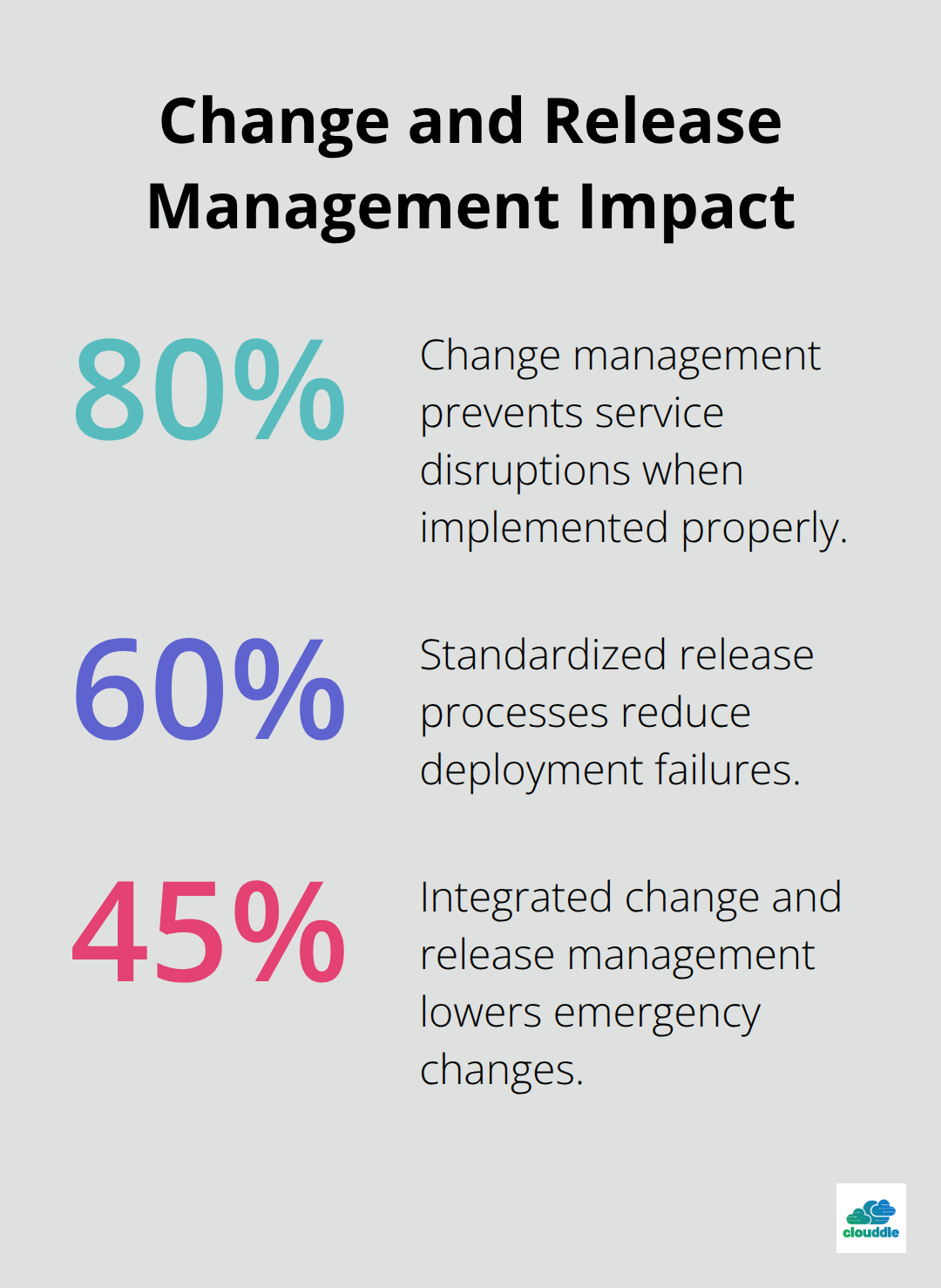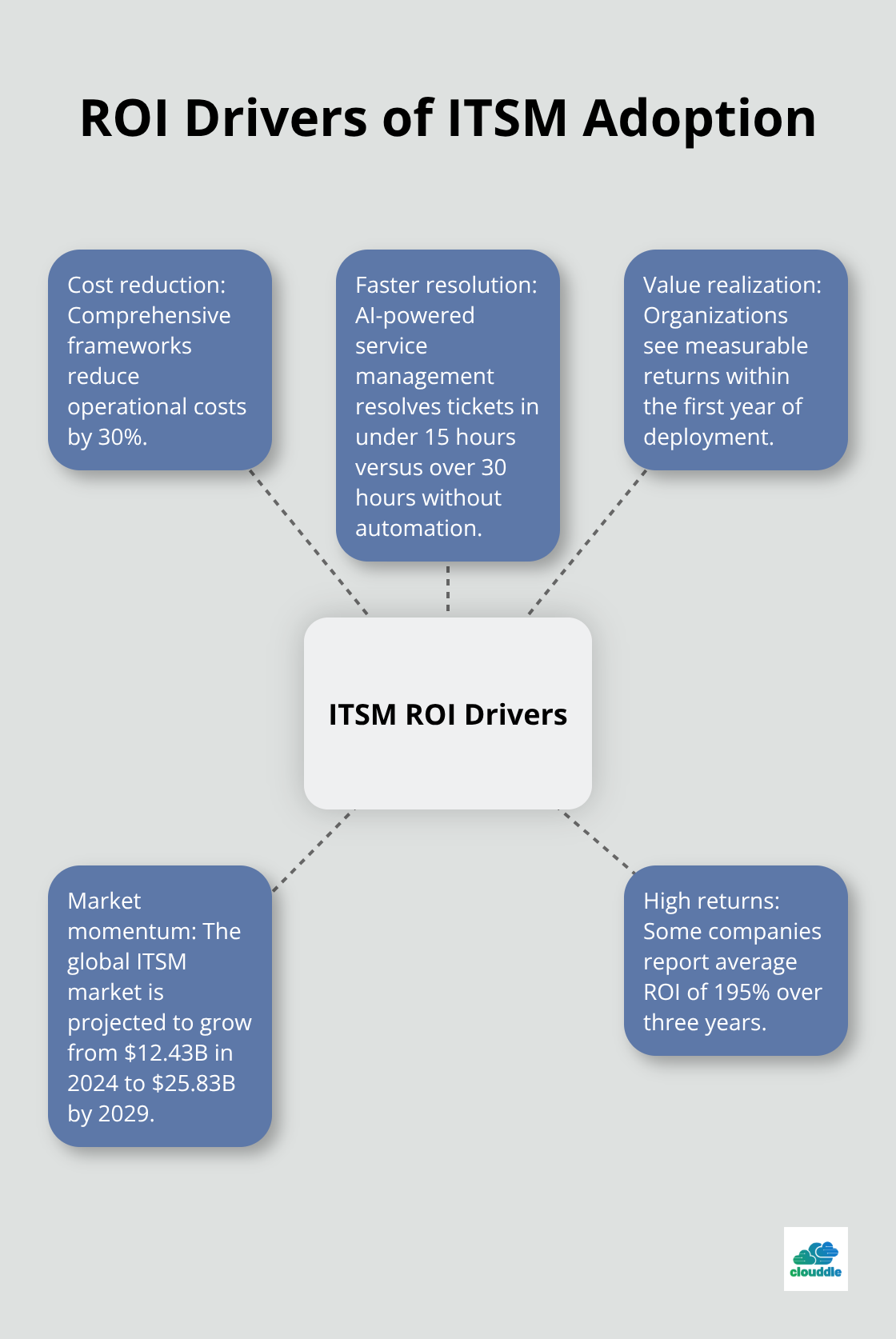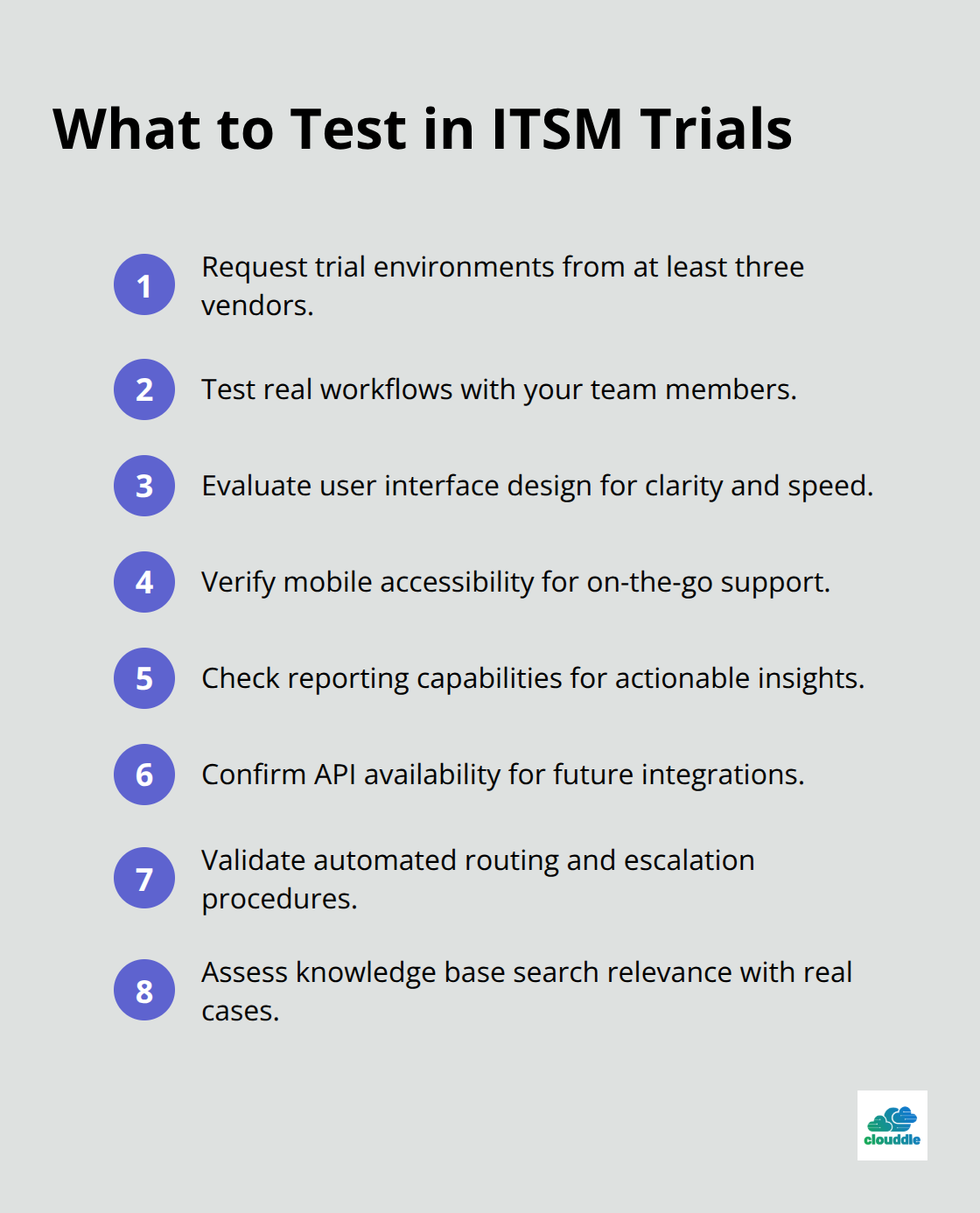IT service management systems have become the backbone of modern business operations, with 87% of organizations reporting improved service delivery after implementation.
These platforms streamline everything from ticket resolution to asset tracking, transforming how IT teams support their organizations. At Clouddle, we’ve seen firsthand how the right ITSM solution can reduce response times by up to 40% while cutting operational costs.
This guide covers the essential components, benefits, and selection criteria to help you choose the perfect system for your needs.
What Core Features Define Modern ITSM Systems
Modern ITSM systems center around three fundamental components that determine their effectiveness. Service desk functionality acts as the central nervous system, managing work through call-to-ticket ratios that help leadership understand how well the Service Center operates. The most effective platforms integrate automated ticket routing, escalation workflows, and knowledge base integration to reduce resolution times. Organizations that use advanced service desk features report 35% faster incident resolution compared to basic systems. Self-service portals have become essential, with studies that show they cost just $2 per incident versus $22 for traditional support calls.
Service Desk and Ticket Management
Service desk platforms handle incident reporting, request fulfillment, and user communication through unified interfaces. Advanced systems categorize tickets automatically, assign priority levels based on business impact, and route requests to appropriate teams without manual intervention. Knowledge base integration provides agents with instant access to solutions, while automated notifications keep users informed about progress. Organizations that implement comprehensive service desk solutions see 42% improvement in first-call resolution rates and 25% reduction in average handling time.
Asset and Configuration Management Integration
Asset management capabilities track hardware, software, and digital resources throughout their lifecycle and prevent costly service disruptions. Data center outages can range from $38,969 to over $1 million per organization, making prevention critical for business continuity. Configuration management databases maintain relationships between IT components and enable impact analysis before changes occur. Organizations with comprehensive asset tracking reduce security vulnerabilities by 28% and improve compliance audit results. The integration between these components allows teams to predict failures, optimize resource allocation, and maintain accurate inventory records.
Change Control and Release Coordination
Change management processes prevent 80% of service disruptions when teams implement them properly, according to ITIL Foundation data. Effective ITSM platforms automate approval workflows, maintain change calendars, and provide rollback procedures for failed implementations. Release management coordinates software deployments across environments and reduces deployment failures by up to 60% through standardized processes. Organizations that use integrated change and release management report 45% fewer emergency changes and 30% shorter deployment windows.

These core components work together to create a foundation for operational excellence, but their true value emerges when organizations understand the tangible benefits they deliver to both IT teams and business stakeholders.
What ROI Can Organizations Expect from ITSM Implementation
Organizations that implement comprehensive ITSM systems generate measurable returns within the first year of deployment. Research from Forrester shows that companies with comprehensive ITSM frameworks see average ROI of 195% over three years while they reduce operational costs by 30%. Companies that use AI-powered service management resolve tickets in under 15 hours compared to over 30 hours without automation, according to SDI research data. The Global ITSM market expansion from $12.43 billion in 2024 to a projected $25.83 billion by 2029 reflects this value recognition.
Service Quality Improvements Drive User Satisfaction
ITSM systems transform user experiences through faster resolution times and proactive service delivery. Organizations with mature service management report 42% improvement in first-call resolution rates and 35% reduction in repeat incidents. Self-service portals reduce support costs from $22 per call to just $2 per incident while they improve user autonomy. Knowledge-Centered Service implementations cut service ticket resolution time by 18%, which allows IT teams to focus on strategic initiatives rather than routine requests.

Operational Efficiency Gains Compound Over Time
Automated workflows eliminate manual processes that consume valuable IT resources and create bottlenecks. Companies that use integrated change management experience 45% fewer emergency changes and prevent 80% of potential service disruptions. Asset management capabilities reduce security vulnerabilities by 28% while they improve compliance audit outcomes. Organizations typically see implementation times drop from 6-12 months with legacy systems to just 34 days with modern platforms (accelerated time to value).
Risk Management Becomes Proactive Rather Than Reactive
ITSM platforms provide visibility into infrastructure dependencies and potential failure points before problems occur. Configuration management databases enable impact analysis that prevents cascading failures across interconnected systems. With cyberattacks that increase 30% year-over-year (according to Check Point Research), robust service management frameworks become essential for security compliance and business continuity plans.
These quantifiable benefits demonstrate why organizations prioritize ITSM investments, but success depends heavily on selecting the right platform that aligns with specific business requirements and technical capabilities.
How Do You Select the Perfect ITSM Platform
Start with a comprehensive requirements assessment that maps your organization’s specific needs against platform capabilities. Document current pain points, service volume metrics, and integration requirements with existing systems like Active Directory, monitoring tools, and business applications. Organizations that conduct thorough needs analysis can reduce implementation risks and achieve faster user adoption rates.
Budget Planning Accounts for Hidden Costs
Budget planning should account for licensing costs, implementation services, training expenses, and ongoing support fees. Most ITSM platforms range from $15-100 per agent per month, but total cost of ownership includes customization, data migration, and workflow configuration expenses that often double initial estimates. Factor in hardware requirements, third-party integrations, and annual maintenance fees when you calculate long-term investment returns.
Platform Comparison Requires Hands-On Testing
ServiceNow leads enterprise deployments with 4.3 user ratings from 1947 reviews, while Jira Service Management serves over 300,000 organizations with strong collaboration features. Atlassian’s platform excels in DevOps integration and agile workflows, making it ideal for software-focused teams. SysAid offers comprehensive AI-powered features for mid-market organizations, while EasyVista achieves 4.9 customer satisfaction ratings for end-to-end service management.
Request trial environments from at least three vendors and test real workflows with your team members. Focus on user interface design, mobile accessibility, reporting capabilities, and API availability for future integrations. Test automated ticket routing, escalation procedures, and knowledge base search functionality with actual use cases from your environment.

Implementation Success Depends on Change Management Strategy
Successful ITSM deployments average 34 days with modern platforms compared to 6-12 months for legacy systems (according to implementation data). Create dedicated project teams with representatives from IT operations, security, and end-user groups to maintain stakeholder alignment throughout the process. Train-the-trainer programs accelerate user adoption and reduce ongoing support costs.
Organizations that invest in comprehensive training programs see 40% higher user satisfaction scores and 25% faster time-to-productivity. Plan phased rollouts that start with core IT teams before expansion to broader organizational groups. Data migration requires careful planning to maintain service continuity and preserve historical ticket information for trend analysis and reporting purposes.
Final Thoughts
IT service management systems deliver measurable value through improved efficiency, reduced costs, and enhanced user satisfaction. Organizations that implement comprehensive ITSM platforms see 195% ROI over three years while they cut operational expenses by 30%. The key to success lies in thorough requirements analysis, proper vendor selection, and strategic change management.
Modern ITSM platforms transform IT operations from reactive firefighting to proactive service delivery. Automated workflows, integrated asset management, and AI-powered ticket resolution enable IT teams to focus on strategic initiatives rather than routine maintenance tasks. Companies that use advanced service management resolve incidents twice as fast as those that rely on manual processes (compared to over 30 hours without automation).
Success depends on platforms that align with organizational needs and technical requirements. Factor in total cost of ownership, integration capabilities, and scalability when you evaluate vendors. For businesses that seek reliable technology infrastructure to support their ITSM initiatives, Clouddle provides managed IT services and 24/7 support across hospitality, multi-family dwelling, and senior living industries.


